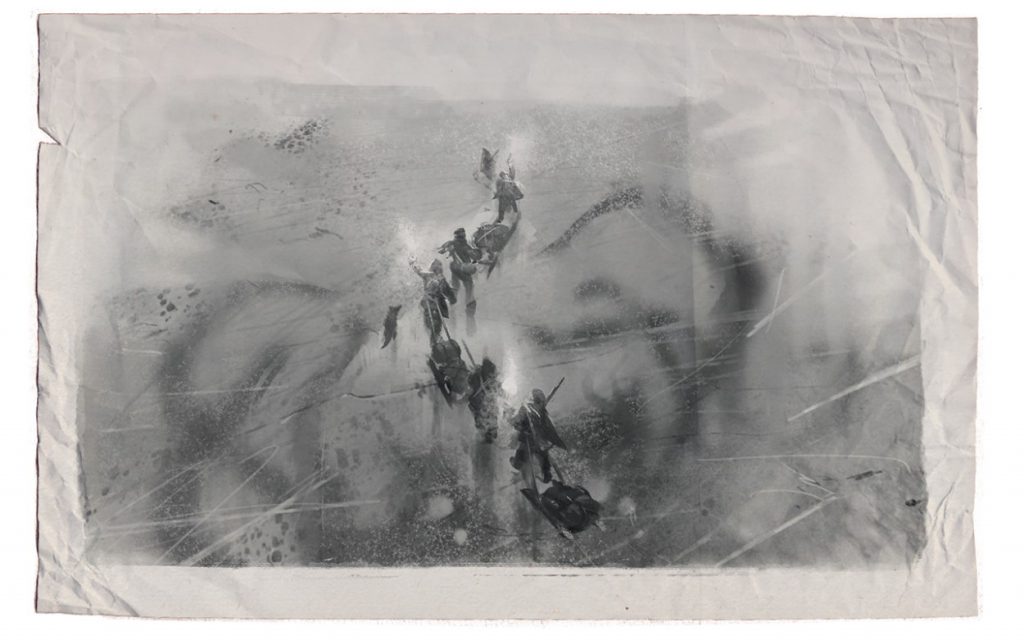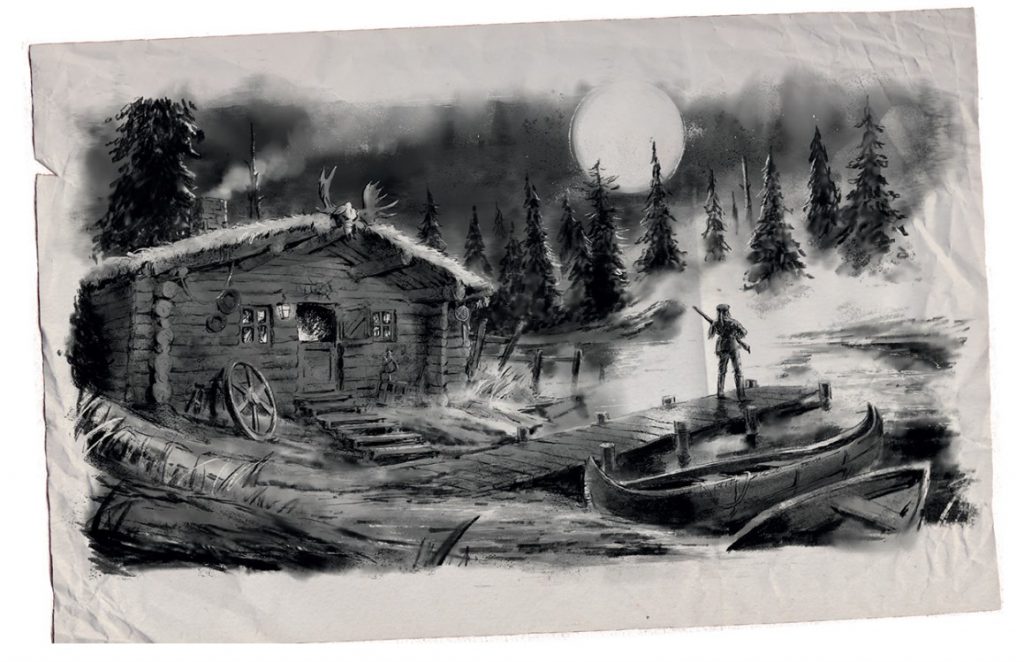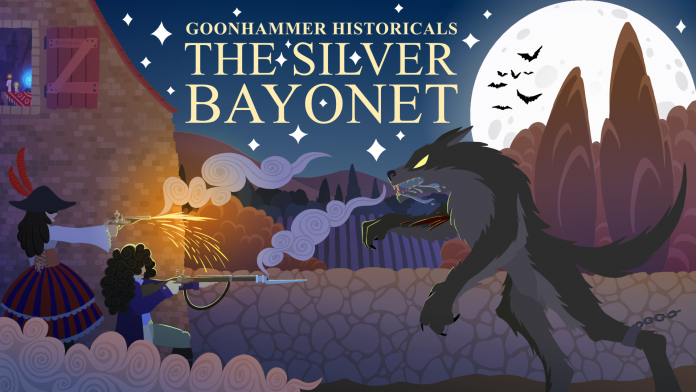The Silver Bayonet: Canada is the second expansion for the highly-regarded gothic horror skirmish wargame. Published by Osprey Publishing, with an accompanying miniatures line from North Star Military Figures, The Silver Bayonet: Canada sees the game in the hands of Ash Barker, the man behind Guerrilla Miniature Games and author of Steel Rift. It also shifts the game out of the familiar “What is Napoleon, but also Werewolves?” setting and out into the New World – which you likely guessed from the name.
The book’s slender 64 pages bring with them a pretty hefty amount of content – four new factions, four new soldier types, five missions for two players, and a three-mission solo campaign, along with eight new monsters and a Canada-appropriate encounter table.
Table of Contents
New Factions
TSB: Canada doesn’t force you to make a new world specific unit, and indeed “Sent over from Europe to sort out some things” is a perfectly viable path for an experienced unit – so much so that it’s setup for the solo campaign. But should you wish to make a new unit, there are four new options: Upper Canada, Lower Canada, The United States, and the Trading Companies.
Upper Canada
The culturally British part of Canada, the Upper Canada recruitment list has some departures from the British recruitment list, most notably the addition of Discovery Servicemen (discussed below), Guards and Woodsmen for the loss of Heavy Cavalrymen, Sailors, and my precious, beloved Riflemen. Overall, it maintains a sort of “Competent Humans” feel to it, especially the North Star squad of an Officer, Junior Officer, Tactician, Native Scout, Highlander, Infantryman, Light Cavalryman and Veteran Hunter.
Lower Canada
The more culturally French environs around Quebec, Labrador and Newfoundland make up Lower Canada, and include some familiar faces, like the Vivandiere alongside a Champion of Faith, and several of the new units such as Voyageurs and Loup Garou (details below). The North Star set leans heavily on some of these units, with an Officer, a Sailor, Infantryman and Native Scout backed up by a Vivandier, Voyageur, Champion of the Faith, and a Loup Garou, which gives it a much more supernatural vibe.
The United States
Resting on the precipice of war with Britain and Canada, the United States has its own supernatural hunting units. The only new unit available to the United States is the Woodsman, with the rest of the list being drawn from the core The Silver Bayonet book. But it’s a fun set, including Riflemen, Champions of Faith, Marines and Native Scouts. The North Star set is very heavy on these military archetypes, with an Infantryman, Veteran Hunter, Light Cavalryman, Sailor, Rifleman, Marine, Native Scout and a Supernatural Investigator.
Trading Companies
Rounding out the list of new factions we have the Trading Companies – essentially Napoleonic Mega Corps, who are out in Canada looking out for their own, quasi-governmental interests. Effectively hiring highly skilled mercenaries, they start out with a modest core recruitment list of the sort of “mundane martial” type characters, but then get to add four from a much wider list to customize their unit. These add-ons include Damphyr, Champion of Faith, Discovery Servicemen, Highlander, Loup Garou, Marine, Occultist, Veteran Hunter, and…Werebear.
Lamentably, Damphyr, Loup Garou and Werebear are mutually exclusive 0-1 options, preventing the formation of an “Oops! All Monsters!” Silver Bayonet unit.
This flexibility is interesting and lends itself well to a sort of motley band of misfits and mercenaries feel. The North Star range goes with the Highlander (this time with a very large axe) and Werebear, but if ever there was a pick-n-mix faction, this is it.
New Soldiers
Discovery Servicemen
Introduced alongside a picture of a rather heroic (and cold) looking young woman holding onto some very icy rigging, Discovery Servicemen are, in effect, professional explorers, primarily looking for the Northwest Passage. None of them will find it (though, as it turns out, they only had to bide their time and wait for climate change to open it up) but they’ll get up to adventures in the meantime. At a somewhat expensive 18 recruitment, they come with Expert Climber and Steady Legs, both of which are more important in the wilds of Canada than the dark forests and ruined villages of Napoleon’s Europe, and come carrying a blunderbuss, which is a nasty, albeit inaccurate weapon. I feel like there’s a lot of modeling potential here, but there’s not a lot saying “I have to take one of these” outside of flavor.

Loup Garou
Werewolves. Okay, not technically Werewolves, because The Silver Bayonet also has Werewolves. Essentially, these unfortunates are cursed with lycanthropy, and have fled to the New World to eek out an existence at the periphery of society – or in Silver Bayonet units who are more than willing to take them on. Normally, they wander around with a hand weapon and pistol, Allergy to Silver and Fire, and Quick Heal. When they turn into a wolf, anything that requires hands is out the door, so no pistol and no investigating clue markers (though I think it would be hilarious to house-rule them being able to investigate those involving scents), but they go from +1 Melee to a substantial +3, +2 Courage, Strong, serious Damage Reduction, Nimble, Quick and Master of Cover. This all comes at a somewhat spendy 30 recruitment, but…it seems pretty darned lethal.
Voyageur
A sort of highly-regarded professional adventurer support staff, the Voyageur is a solid all-rounder at 20 recruitment. With standard stats, they have Steady Legs (again – important in the Canadian wilds) and Strong which makes them slightly more deadly in melee. They’ve also got a rifle, which gives them better range, and is a good way to burn any extra Skill Dice hanging out in your Fate Pool.
Woodsman
If you’ve been looking for some cheaper units unique to the Canadian setting, the Woodsman is it, coming in at 15 recruitment points. Armed with a rifle and middling stats, they come with Nimble to make short work of wild terrain, and Fire Starter, which allows them to swap whatever they’re carrying from the Special Armory for Oil and Torches, which is handy in a pinch if you’ve picked the wrong loadout for your troops.
The New Campaigns
One of the first things included in the “Adventures in the North” section with the new missions is a list of every model and monster you might encounter in your adventures. For those of us trying to source models, 3d print them, etc. it’s nice to have the full list, and it’s nice to not have to spoil things. This is especially important for the single player campaign, where it’s very easy to tailor your unit if you know what’s coming. This is just such a nice quality of life improvement for not a lot of effort, and I would love for more games to include it.
The second thing that comes out as you read the missions is that Ash has, by and large, avoided making the game’s theme some triumphalist, (White) Mankind’s Victory Over Nature. The feeling that pervades the book is that we’re ruining it, and that the source of much of the misery in the campaign is the Harvestmen exploiting human weakness in a setting with little travel and lots of isolation. And the source of most of the misery that isn’t that? Mostly that the wilderness will happily kill you, no supernatural explanation required.

The terrain you’ll need for the campaigns is also lightweight – some buildings, enough to make up a small frontier fort, elements for a small farm and a lot of rocks and trees should do you just fine.
The missions themselves are a lot of fun – they’re characterful, give a great frontier feeling, and exhibit some of those fun tradeoffs between gathering information and shooting at the other side, and balancing which will get you out with the most XP and the fewest casualties.
Just How Hard is the Solo Campaign?
The solo campaign comes with a warning – that it’s intended for experienced Silver Bayonet units, and that the setup is that one of these veteran units has been sent to Canada on a mission. There’s a daunting hunger mechanic that comes along with it, and if a member of your unit is lost, they’re gone – there’s nowhere to take on replacements to replenish your force.
What isn’t said is what “experienced” means – especially since experience in The Silver Bayonet comes slowly, and it’s a long time before you’re hitting major, significant stat increases, especially if you’re also taking losses. So I figured why not play it with what I’d consider a reasonable unit for this campaign – one with the main The Silver Bayonet solo campaign behind it, along with four battles with other players with varying levels of success. And thus did an intrepid band of an Officer, a Supernatural Investigator, two Infantrymen, two Riflemen, a Highlander and an inexperienced Marine head out into the frozen wilderness.
Reader, it was fine.
No seriously. I got a little lucky with some rolls, but I escaped the three-mission campaign having had to make only two permanent injury rolls and having been able to completely ignore the hunger mechanic after the first game. I suspect you can get away with even less experience. Of course, part of the question is “What does it mean to get through the campaign?” The Silver Bayonet is wonderfully free of clear wins and losses – it’s more about getting XP, preserving your force, etc. So is “to get through the campaign” to get through it with minimal losses, or to have a few haggard veterans with haunted expressions stagger into the nearest frontier outpost with tales of lost friends and angry bears?

While we’re on the topic of the solo campaign, it definitely feels a little bit like a prelude campaign, or something of a tech demo that introduces some very cool mechanics that you can work into a longer solo campaign. It’s a solid one, but it’s one that could be played through in a few hours of solid gaming. I do have one mechanical complaint however – four out of the 14 total clue markers in the solo campaign reward the player with Monster dice.
Monster dice expressly aren’t used in solo campaigns of Silver Bayonet.
I don’t really know what Ash intended here – if the player is just meant to use the “Redirect the Monster toward not-the-closest-target” effect, which is the only one that makes sense, or if this should genuinely be something else and just needs errata.
There’s also some ambiguity in terrain setups that will wildly change the difficulty of a mission. For example, the last mission has clue markers that, like in many scenarios, provide players with the weaponry they need to fight a supernatural foe. It specifies that there are three of these, and they should be placed in a circle, 10” from the center of the table and roughly equidistant. By my reading, this forms a “Y” shape, but there’s no specification of which way this “Y” should be facing – putting more clue markers closer to the monsters will make it harder, putting them closer to the party will make it much easier.
But, having played it over three evenings, I had an excellent time, and am ready for more, which is really the point.
On Representation
To be blunt, wargaming’s history with First Nations and American Indian representation generally falls along the spectrum between “Poor” and “Appalling.” This is particularly important to me, as both my spouse and some very dear friends are members of this group, including members of tribes who still inhabit the lands this book covers. And I’ve seen how hard it hits when gaming as a broad hobby treats indigenous peoples the way it does. I’ll be honest, I was braced for something pretty dire.
I was pleasantly surprised. From my reading, Ash’s heart is in the right place. I’ve read enough land acknowledgements to know when they’re being phoned in, and the one at the front of the book doesn’t feel like that.

But I’m not really the person who should be judging this. So I the asked aforementioned friends. In particular, I’d like to acknowledge and thank Coral B. for her thoughtful readthrough of the book and discussion with me.
By and large, Silver Bayonet: Canada got pretty good marks. There are a few missteps – specifically called out was an overemphasis on harmony with nature, vast unpopulated wilderness, etc.) – common stereotypes that arise even in well intentioned work. The choice not to go with all Native monsters, and indeed often not monsters at all, was both unexpected and very welcome.
Bears are proper scary all on their own.
The monsters and elements of Native culture that are used are drawn from a broad geographic range, but by and large this seemed relatively unobjectionable. And the miniatures range from North Star got high marks.

There’s just one real record scratch moment. The use of the W****go as a monster. There are a lot of resources for why this particular monster shouldn’t be used (e.g. this paper – warning, this goes straight to a PDF). They are rooted in a very specific context, community and culture, and the use outside that culture is something that has been widely discouraged by the communities in question and is pretty much textbook appropriation. This is far from the worst example of the westernization of this particular monster, but ideally, it wouldn’t be there at all. In my own game, I substituted a very large and obviously supernatural wolf – the kind of thing that I felt fit better with the overall aim of the book to suggest that the malign and corrupting influence of the Harvestmen and increasing colonization might be the source of many of Canada’s supernatural woes.
Overall Impressions
Overall, I think Silver Bayonet: Canada is a worthwhile addition to the Silver Bayonet line. The new units are interesting without being must-haves, and the addition of four new groups gives experienced players an excuse to start another force. It also brings a refreshing tone to Silver Bayonet games – a shift from gothic to survival horror, the idea that the wilderness is quite capable of killing you without any help from the supernatural, and an adventure that is taking place in a setting on the brink of war, rather than dead in the middle of it.
Questions, comments, suggestions? Get in touch at contact@goonhammer.com or leave a comment below


